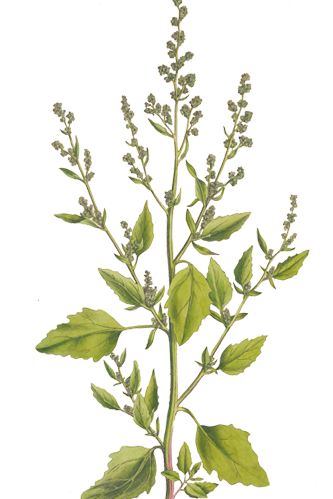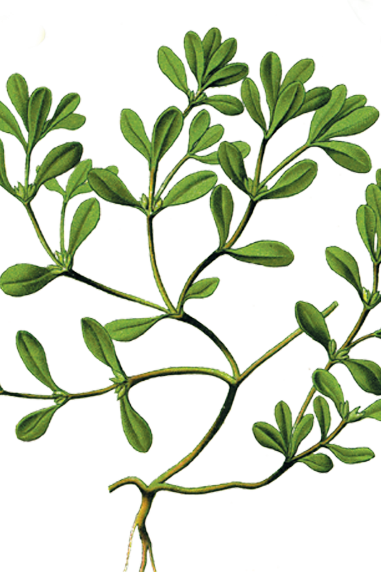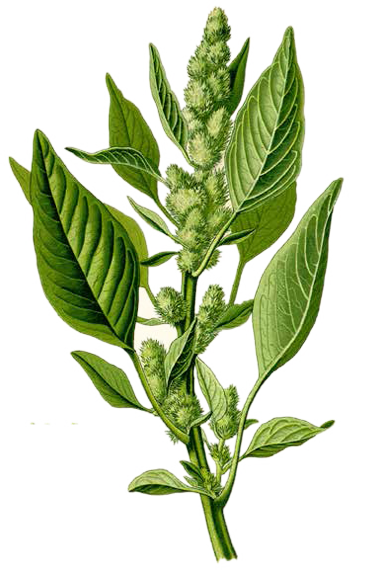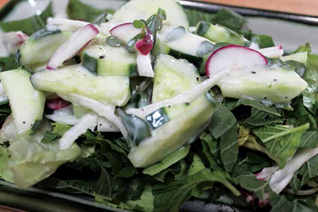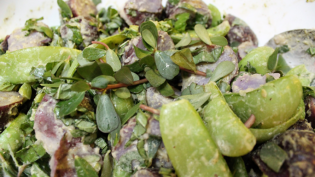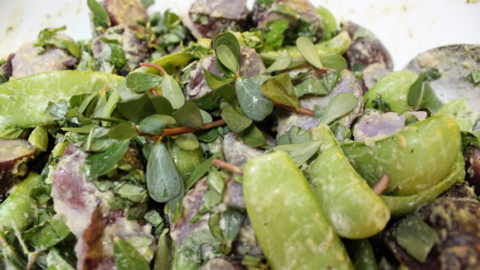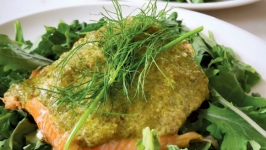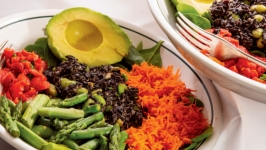In the Garden: Eat Thy Enemy
I have long understood that purslane could be used in salads or soups but I never made much of an effort to harvest it until a few years ago. Now, when high summer approaches I am on the hunt for purslane, considered a noxious weed by many. I am not the only one who regards purslane as a culinary virtue.
A few years ago, a fellow gardener sampled some of his homemade salsa that he was snacking on and commented, “It is the best way to use purslane.” I was so excited to hear someone else get excited about this so-called weed.
This year it grows in our kitchen garden in a most deliberate way, although it was not deliberate at all. It looks fantastic spreading out between the stepping stones. Author Nancy Gift describes purslane (Portulacca olereaca) as a “flat-growing plant with succulent, thick leaves, usually roughly an inch long, and a thick stem. It grows best in dry places (sand, gravel) but also grows in gardens. Purslane leaves are deep green, slightly shiny, with small whitish hairs underneath, and the leaf edges and stems often have a purplish or reddish cast.”
Simply put, it has a jade-like appearance for a weed. In Nancy’s book Good Weed, Bad Weed, she definitely represents the good side of the piquant-tasting green. Purslane is an annual that likes the heat of summer; it will get knocked backed by the first frost so be sure to harvest your last batch for a fall gumbo. When purslane is cooked in a broth it acts as a thickening agent, similar to okra.
One of the ways I sell a purslane concoction to my guests is by bragging on the nutrient values of this succulent: It is high in omega-3 fatty acids, vitamin C, beta carotene, magnesium, potassium and a little calcium — therefore good for blood pressure and cholesterol. Why are we not eating more of this?
I largely use purslane raw in dishes that complement its lemony, sour-piquant flavor. Everyone’s favorite is the purslane potato salad. It is also a fantastic complement to a cucumber and yogurt salad, or you can just add a few of its leaves to any leafy green salad.
Another tasty weed is Chenopodium album, also known as lamb’s quarters or wild spinach. I first ate lamb’s quarters in a salad at the National Museum of the American Indian in Washington, DC. Their Mitsitam Café has five food stations that represent different regional cuisines and their mixed salad was full of tasty weeds! When we returned home, I set to the task of weeding the asparagus bed, which produced a bountiful harvest of lamb’s quarters.
Their slightly fuzzy quality means that tender young leaves are ideal for salads and older leaves in a sauté. Lamb’s quarters tops the chart in nutritional value: 100 grams provides 232% of the recommended daily dose of vitamin A, 133% of vitamin C, 30% of calcium, 15% B-6, 8% magnesium and 6% iron. “Wild spinach” is a suitable moniker because when it is cooked it tastes just like spinach, so use it in any preparation where you would use spinach. I am thinking pizza.
One more weed is on the menu: amaranth greens. Amaranth is an ancient grain but the foliage is also an important food crop in many parts of the world. I grew amaranth one year as a trap plant for cucumber beetles with the slightly naive expectation that the beetles would only eat the amaranth. They mostly did, but they still spread disease to the cucumbers. So, here is a bit of a cautionary tale: Once you plant amaranth, you have amaranth.
It can be a noxious weed in large agricultural operations and is known as pigweed around here. I keep it under control by preventing it from flowering. Harvest all the greens you want but keep the flowers pinched back. In fact, the more you pinch clusters of leaves and remove emerging flowers the more new leaves the plant will produce for you. It is quite similar to pinching leaves from a basil plant. Pinching out one stem results in the growth of two new lateral stems. So, a small cluster of amaranth can provide you with greens all summer long.
I prefer cooking amaranth because of the coarse texture of the leaves. Cooking it also brings out its nutty flavor. Amaranth is super nutritious so it may be worth encouraging a little patch and adding it to your repertoire of greens. Here are a few basic recipes to get you started experimenting with wild greens.
Amaranth Frittata
This is a great make-ahead breakfast for before school or work because it reheats nicely.
Heat some oil in an iron skillet, add minced onion and your rough-chopped amaranth. Saute just to wilt your greens.
Whip up 4–6 eggs and pour over the wilted greens.
Add thinly sliced tomatoes and feta cheese to the top while you let the eggs set for about 1 minute.
Transfer the skillet to a preheated 350 degree oven to finish.
Esther Heizer’s Fall Gumbo
Ms. Heizer, of Clarksville, Indiana, sent this recipe to my father over 20 years ago.
Saute 1/2 cup chopped onion in about a tablespoon of butter; blend in about a tablespoon flour.
Add 1 cup of chopped tomatoes, 2 cups (or more) of stock, about 1/2 pound cubed fish or chicken (or keep it vegetarian and add additional vegetables), 2 cups purslane and a handful of chopped fresh basil.
Let it all simmer until meat is cooked through and the vegetables are tender.
Serve over rice.



